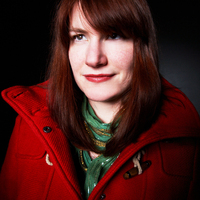
Dr. Anna Blagrove
I am a Lecturer in Animation and Visual Effects at Norwich University of the Arts (part-time). I have a film research PhD, from the University of East Anglia (UEA), school of Art, Media, and American Studies. My PhD title is 'Teens’ Screens: The Places, Values, and Roles of Film Consumption and Cinema-Going for Young Audiences'. My external examiner was Prof. Sarah Atkinson, King College London. I was a Module Convenor and Associate Tutor for numerous Film and Media Studies modules at UG and PG level whilst at UEA.
I am a Director of the Community Interest Company (CIC), Reel Connections, where we use film and music to engage community groups and individuals. In early 2020 I was part-time Partnerships and Outreach Manager for the Green Film Festival @UEA.
I worked as a Film Education Officer at Norwich's Picturehouse, Cinema City from 2007-2018. My involvement with a Heritage Lottery Funded project entitled 'Norfolk at the Pictures' has enabled me to be Associate Producer on a feature-length documentary film titled, THE FINAL REEL: The Story of our Love Affair with Cinemas.
Supervisors: Dr. Mark Rimmer, Prof. Keith Johnston, Prof. Mark Jancovich, and Emeritus Prof. Martin Barker
I am a Director of the Community Interest Company (CIC), Reel Connections, where we use film and music to engage community groups and individuals. In early 2020 I was part-time Partnerships and Outreach Manager for the Green Film Festival @UEA.
I worked as a Film Education Officer at Norwich's Picturehouse, Cinema City from 2007-2018. My involvement with a Heritage Lottery Funded project entitled 'Norfolk at the Pictures' has enabled me to be Associate Producer on a feature-length documentary film titled, THE FINAL REEL: The Story of our Love Affair with Cinemas.
Supervisors: Dr. Mark Rimmer, Prof. Keith Johnston, Prof. Mark Jancovich, and Emeritus Prof. Martin Barker
less
Related Authors
Judith L Green
University of California, Santa Barbara
Andrekos Varnava
Flinders University of South Australia
Kate Nash
University of Leeds
Göran Bolin
Södertörn University
Philip Napoli
Duke University
Victor Pickard
University of Pennsylvania
Mark Ryan
Queensland University of Technology
Ramón Salaverría
Universidad de Navarra
Stephen Morgan
King's College London
Ellen Wright
De Montfort University
InterestsView All (12)










Uploads
Papers by Dr. Anna Blagrove
Australian film, Red Dog as a popular cultural product from Western Australia. Set in a working class mining community in the 1970s, I argue that it provides a new outback legend in the form of Red Dog. This article stems from a review of Red Dog as Film of the Year written for the forthcoming Directory of World Cinema: Australian and New Zealand Second Edition from Intellect Books.
Conference Presentations by Dr. Anna Blagrove
Abstract
What are the practices and roles of cinema-going and film consumption for contemporary British youth? This presentation, based on my PhD, is an investigation into 13-18 year old’s current cinema-going and film-watching habits via new ethnographic research. It strengthens scholarship on young film consumers and bridges a gap between academia and the film exhibition industry.
The BFI reports that, across all UK cinemas, ‘the share of the cinema-going audience amongst 15-24 year olds has seen a significant drop over recent decades: in the 1990s this group regularly made up over 40% of the audience whereas in 2017 they represented just 28%, the lowest audience share in the past 20 years (BFI 2018)’. Furthermore, teen audiences make up only a tiny fraction of specialised cinema audiences. My paper therefore explores how different social groups of young people attach different meanings and uses to diverse film viewing practices, texts and locations.
Using original empirical data collected from 42 teenagers via 26 focus groups, interviews, and participant observation encounters; my findings are reached via the theoretical framework of Pierre Bourdieu’s concepts of cultural capital and habitus (Bourdieu 2010 [1984]). I decode meanings from my young participants’ discourse and behaviour whilst taking into account their particular socio-cultural contexts. By categorising my participants into six different groups, I argue that young people’s socio-economic and cultural contexts remain a significant influence on film viewing practices, tastes, and gratifications.
Ultimately I present a new model of film consumption for teenagers, and offer an academic intervention into the study of the development of young audiences for a broader range of film in twenty-first century Britain.
The poster is intended to introduce the conundrum of the ageing art-house cinema audience. It will present my PhD research which is an exploration of the meanings of cinema-going for young people via interviews, focus groups, and observation. It is an investigation into 13-18 year old’s current cinema-going and film-watching habits and the barriers that young people may perceive as reasons not to visit venues such as Picturehouse or Curzon cinemas. The ultimate aim is to influence future audience development policies concerning younger audiences.
I argue that the narratives of Studio Ghibli’s films often have a strong sense of location, community, and harmony which is threatened by industry or pollution. Frequently there are spirits or kami, that communicate these themes. I refer specifically to My Neighbour Totoro, Spirited Away, and Ponyo whilst also commenting on the wider Ghibli filmography. I frame my arguments by focusing on the themes of environment, location, and spirituality in turn.
Through textual analysis, I examine how the characters (both human and magical), and narrative, as well as Ghibli animation aesthetics convey these themes. I review existing literature on the subject and access published interviews with Miyazaki to inform my conclusions.
I will look at the wider context of environmental issues in modern-day Japan, including urban sprawl and the threat of earthquake and tsunami. Finally I will draw some conclusions of the overriding ‘morals of the story’ relating to environment and spirituality.
Book Reviews by Dr. Anna Blagrove
Australian film, Red Dog as a popular cultural product from Western Australia. Set in a working class mining community in the 1970s, I argue that it provides a new outback legend in the form of Red Dog. This article stems from a review of Red Dog as Film of the Year written for the forthcoming Directory of World Cinema: Australian and New Zealand Second Edition from Intellect Books.
Abstract
What are the practices and roles of cinema-going and film consumption for contemporary British youth? This presentation, based on my PhD, is an investigation into 13-18 year old’s current cinema-going and film-watching habits via new ethnographic research. It strengthens scholarship on young film consumers and bridges a gap between academia and the film exhibition industry.
The BFI reports that, across all UK cinemas, ‘the share of the cinema-going audience amongst 15-24 year olds has seen a significant drop over recent decades: in the 1990s this group regularly made up over 40% of the audience whereas in 2017 they represented just 28%, the lowest audience share in the past 20 years (BFI 2018)’. Furthermore, teen audiences make up only a tiny fraction of specialised cinema audiences. My paper therefore explores how different social groups of young people attach different meanings and uses to diverse film viewing practices, texts and locations.
Using original empirical data collected from 42 teenagers via 26 focus groups, interviews, and participant observation encounters; my findings are reached via the theoretical framework of Pierre Bourdieu’s concepts of cultural capital and habitus (Bourdieu 2010 [1984]). I decode meanings from my young participants’ discourse and behaviour whilst taking into account their particular socio-cultural contexts. By categorising my participants into six different groups, I argue that young people’s socio-economic and cultural contexts remain a significant influence on film viewing practices, tastes, and gratifications.
Ultimately I present a new model of film consumption for teenagers, and offer an academic intervention into the study of the development of young audiences for a broader range of film in twenty-first century Britain.
The poster is intended to introduce the conundrum of the ageing art-house cinema audience. It will present my PhD research which is an exploration of the meanings of cinema-going for young people via interviews, focus groups, and observation. It is an investigation into 13-18 year old’s current cinema-going and film-watching habits and the barriers that young people may perceive as reasons not to visit venues such as Picturehouse or Curzon cinemas. The ultimate aim is to influence future audience development policies concerning younger audiences.
I argue that the narratives of Studio Ghibli’s films often have a strong sense of location, community, and harmony which is threatened by industry or pollution. Frequently there are spirits or kami, that communicate these themes. I refer specifically to My Neighbour Totoro, Spirited Away, and Ponyo whilst also commenting on the wider Ghibli filmography. I frame my arguments by focusing on the themes of environment, location, and spirituality in turn.
Through textual analysis, I examine how the characters (both human and magical), and narrative, as well as Ghibli animation aesthetics convey these themes. I review existing literature on the subject and access published interviews with Miyazaki to inform my conclusions.
I will look at the wider context of environmental issues in modern-day Japan, including urban sprawl and the threat of earthquake and tsunami. Finally I will draw some conclusions of the overriding ‘morals of the story’ relating to environment and spirituality.